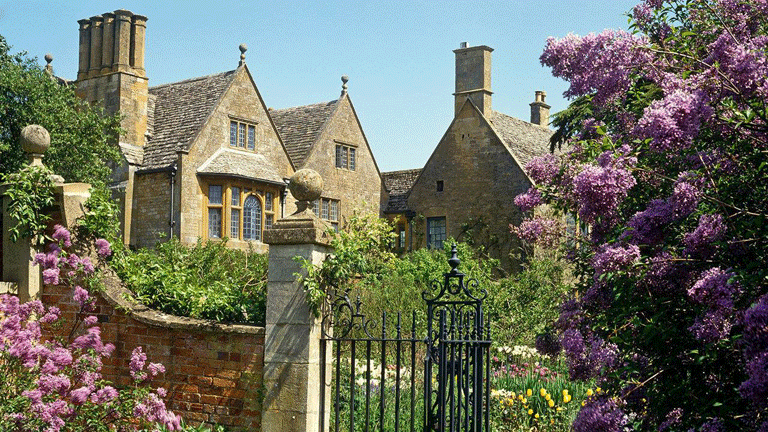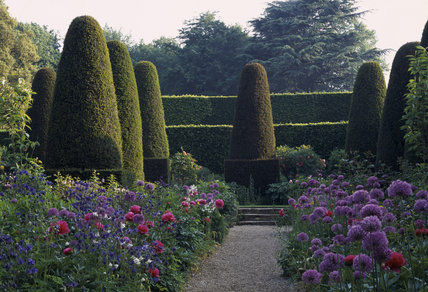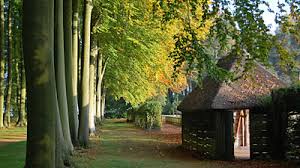
Hidcote Manor Garden is a garden in Gloucestershire. It is one of the best-known and most influential Arts and Crafts gardens in Britain, with its linked "garden rooms" of hedges, rare trees, shrubs and herbaceous borders. Created by Lawrence Johnston, it is now owned by the National Trust and is open to the public.
I spent one week in September with a companion in tow, visiting many of the famous gardens in Gloucestershire. We visited five gardens and Gloucestershire Cathedral, and as Hidcote Manor and Kiftsgate Court were three minutes apart we visited them on the same day. So I hope you will forgive me if my descriptions aren't as detailed as usual for as I look back on that week all I can see is a haze of dappled sunlight on flower borders and the rolling hills and woods of the Cotswolds, all blurred into one perfect summer.
Traveling through twisting country lanes, we arrived at Hidcote Manor. We walked through the blue gates and pillars into the courtyard, the manor stood in front of us with a small chapel on our left. All of the other gates and doors were painted in the same dark muted blue and wisteria tumbled over the sides of the other buildings. We were handed our maps and we set off to the first garden behind the manor, the Old Garden.
Here were two large borders set against the backdrop of the house, a cedar of Lebanon stood at the end of the grass path, swaying in the breeze. I have become quite fond of cedars of Lebanon and to see one at the centre of such a rich garden was wonderful. The borders were lush and was surprised to find irises amongst the foliage in autumn.
Underneath the bows of the cedar a gap in the hedge led down a small flight of steps. We had reached the White Garden. I have always loved white gardens, the delicate beauty of the palate. Here they had paired soft planting with clipped topiary and created a small sunken courtyard. I have read that when one plants a white garden, one is really planting a green garden and here that was very evident in its lushness.

Through another gap in the hedge and we were in the Maple Garden. Hidcote is famous for its garden rooms and as we entered this one I took note of its differences. The maples that gave the garden its name stood amongst the borders, in rich reds and chartreuse. It had not quite reached its autumn peak and glowed quietly, waiting for its moment to shine.
Back through the Old Garden and we had reached the Circle. Here in spring it would be overflowing with purple blossom but now it stood restfully as a gateway to the first vista, on to the Red Border.
The name is self explanatory, the borders with rich and were full with clever uses of foliage like banana trees and maples. There were dark leafed dahlias and grasses, all leading up to two gazebos and a distant gleam of sky that promised a view.
Up the steps, past the gazebos and we were in the Stilt Garden. Here hornbeam had been trained into walls which drew the eye down to the gate where the view was waiting. It was Heaven's Gate, the view stretched down throughout the valley, woods and fields all beneath a vast sky.
At this point we had to double back to the Circle, taking a right through a door in a hedge made of a mix of beech and holly. We walked though the Fuchsia Garden and down into the the Bathing Pool Garden. A fountain trickled and the blue sky was reflected in the water.
Another right and it opened into the Upper Stream Garden. It was hard to tell where the garden ended due to the height and density of the planting, it felt as though one was lost in a nicely planted jungle. Over a small bridge at the centre, we made our way to Mrs Winthrop's Garden.
It was a small courtyard with a small sundial at its centre, the planting was mostly green with splashes of blue and yellow. Hidcote's creator Lawrence Johnston made this garden in memory of his mother which you can learn more about in the documentary in the Content Considerations at the end of the page.
We were now on the Long Walk, the second famous vista of Hidecote, a grass walk stretched out for what seemed like forever.
We choose to go straight ahead into the Pillar Garden. Here yew had been trained into tall pillars towering up amongst the flower beds.
We were back by at Heaven's Gate, to the right was another gap in the hedge, this one lead to the Theatre Lawn. A large lawn sprawled out before us, a small flight of steps led to the stage bounded with a yew hedge. Beyond this was one of my favourite parts of Hidcote, The Beech Alley.
Tall Beeches formed a straight line, the leaves teetering on the edge of autumn colour. On the left was a woodland dappled with sunlight, on the other side there was a tennis court hidden somewhere behind a hedge and the voices of women laughing as they played a game carried down the Alley.
The Beech Alley led to the Kitchen Gardens, we walked around the perimeter and reached
the Rose Walk. The roses were fading and eryngium had taken over the show, an intricate white bench sat at one end looking through an arch of wisteria.

My companion wanted to go back and take a close look at the kitchen gardens so I went and rested on a bench in the Orchard. None of the other visitors walked this far, choosing to follow the Rose Walk, leaving the orchard entirely to me. Dappled in sunlight, the grass was a rich emerald green, looking up I could see only a few apples determined to hold on at the furthest branches of the trees.
Returning from their vegetable investigations, my companion and I headed down the Rose Walk where we reached the Plant House and the Lily Pool. Beyond this was the house and we made our way back to the courtyard for here was my favourite part of every National Trust property, the bookshop.

I have never not found treasure in one of these bookshops and on this occasion I found a copy of The Sun in My Eyes by Beverley Nichols, or how not to go round the world. Inside there was a an Ex Libris sticker that informed me that this book belonged to Fred Whitsey, on the opposite page 'Hidcote Manor Garden' had been stamped and then crossed out.
Fred Whitsey was the Gardening Correspondent for the Sunday Telegraph and later the Daily Telegraph for many years. He was awarded the RHS Gold Veitch Memorial Medal and the Victoria Medal of Honour. In 2007 Whitsey wrote The Garden at Hidcote, filled with photography by Tony Lord. He wrote of Hidcote and its creator Lawrence Johnston that:
"It is the work of an artist using plants as his palette, the earth as his canvas."
I can only assume that Fred Whitsey, who died in 2009 at the age of 90, donated the Beverley Nichols book to Hidcote, before or after his death I could only guess but the volunteers running the library had decided to sell it, to them I'm sure the book came across quite dated. 'The Sun in My Eyes' is the outcome of a six month tour by Beverley Nichols and his partner Cyril Butcher, and is filled with photographs taken by Cyril. Of course the book came home with me.
Reading Recommendations & Content Considerations

by
Fred Whitsey




























































































































































































































































































































































































Comments